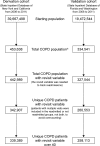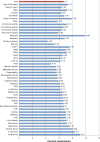Readmission After COPD Exacerbation Scale: determining 30-day readmission risk for COPD patients
- PMID: 28721034
- PMCID: PMC5500510
- DOI: 10.2147/COPD.S136768
Readmission After COPD Exacerbation Scale: determining 30-day readmission risk for COPD patients
Abstract
Background: COPD affects over 13 million Americans, and accounts for over half a million hospitalizations annually. The Hospital Readmission Reduction Program, established by the Affordable Care Act requires the Centers for Medicare and Medicaid Services to reduce payments to hospitals with excess readmissions for COPD as of 2015. This study sought to develop a predictive readmission scale to identify COPD patients at higher readmission risk.
Methods: Demographic and clinical data on 339,389 patients from New York and California (derivation cohort) and 258,113 patients from Washington and Florida (validation cohort) were abstracted from the State Inpatient Database (2006-2011), and the Readmission After COPD Exacerbation (RACE) Scale was developed to predict 30-day readmission risk.
Results: Thirty-day COPD readmission rates were 7.54% for the derivation cohort and 6.70% for the validation cohort. Factors including age 40-65 years (odds ratio [OR] 1.17; 95% CI, 1.12-1.21), male gender (OR 1.16; 95% CI, 1.13-1.19), African American (OR 1.11; 95% CI, 1.06-1.16), 1st income quartile (OR 1.10; 95% CI, 1.06-1.15), 2nd income quartile (OR 1.06; 95% CI, 1.02-1.10), Medicaid insured (OR 1.83; 95% CI, 1.73-1.93), Medicare insured (OR 1.45; 95% CI, 1.38-1.52), anemia (OR 1.05; 95% CI, 1.02-1.09), congestive heart failure (OR 1.06; 95% CI, 1.02-1.09), depression (OR 1.18; 95% CI, 1.14-1.23), drug abuse (OR 1.17; 95% CI, 1.09-1.25), and psychoses (OR 1.19; 95% CI, 1.13-1.25) were independently associated with increased readmission rates, P<0.01. When the devised RACE scale was applied to both cohorts together, it explained 92.3% of readmission variability.
Conclusion: The RACE Scale reliably predicts an individual patient's 30-day COPD readmission risk based on specific factors present at initial admission. By identifying these patients at high risk of readmission with the RACE Scale, patient-specific readmission-reduction strategies can be implemented to improve patient care as well as reduce readmissions and health care expenditures.
Keywords: chronic obstructive pulmonary disease; readmission; risk assessment; risk factors.
Conflict of interest statement
Disclosure The authors report no conflicts of interest in this work.
Figures




References
-
- Centers for Medicare and Medicaid Services National Health Expenditure Data: Historical. 2015. [Accessed April 21, 2016]. Available from: https://www.cms.gov/Research-Statistics-Data-and-Systems/Statistics-Tren....
-
- Fuchs VR. The gross domestic product and health care spending. N Engl J Med. 2013;369:107–109. - PubMed
-
- Medicare Payment Advisory Commission March 2016: Report to the Congress: Medicare Payment Policy (Chapter 3 Hospital inpatient and outpatient services) 2016. [Accessed March 06, 2017]. Available from: http://www.medpac.gov/docs/default-source/reports/chapter-3-hospital-inp....
-
- Centers for Disease Control and Prevention Increase Expected in Medical Care Costs for COPD. [Accessed March 07, 2017]. Available from: https://www.cdc.gov/features/ds-copd-costs/
Publication types
MeSH terms
LinkOut - more resources
Full Text Sources
Other Literature Sources
Medical

